AMERICAN FOOTBALL MONTHLY THE #1 RESOURCE FOR FOOTBALL COACHES
Article CategoriesAFM Magazine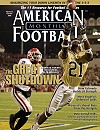
|
Maximizing Your Down Lineman in the 3-5-3 Defenseby: Mike Kuchar© More from this issue It is often said that necessity is the mother of all invention. Such has been the case with the trend of the 3-5-3 (or the hybrid 3-3-5), or odd stack defense. While the scheme’s origins trace back to the mid 1990’s, when defensive coordinators Joe Lee Dunn at Mississippi State and Charlie Strong at South Carolina began penning its initial blueprints – now it’s trickled down to over a couple dozen teams at the collegiate level and some high school programs have even started to catch on. The necessity is getting more speed on the field – especially when facing the spread offenses that have infiltrated the football landscape. There is no better way to do that, then by trimming the fat, literally. Coordinators are finding means to get more agile athletes in space and letting them run around and make plays. Nowhere has this change been more apparent than on the defensive line where the ideals of agility and quickness have replaced the traditional, old school concept of having massive lineman plugging two gaps and just taking up space. While all teams use three defensive linemen in the scheme, how they use them is an entirely different issue. According to the coaches we spoke with there are two schools of line play in the odd stack. The first is an attacking and stunting front, movement on nearly every snap- that is usually backed up by man free coverage in the secondary (Diagram 1). 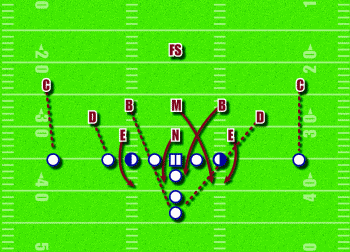
Diagram 1. The second principle is using the odd stack as a base front, as a read and then react defense while playing some type of zone coverage, usually cover three behind (Diagram 2). We’ll present both philosophies in this article. 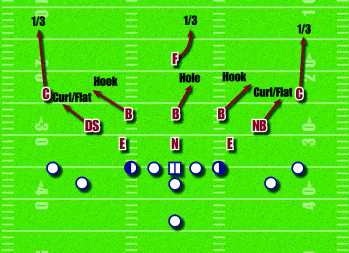
Diagram 2. But before we do that, we should take a look at the type of personnel it takes to run it successfully. Most coaches feel it takes a different kind of defensive lineman to fit the scheme of the odd stack. So if you’re a high school coach wondering if you got the players up front to play the scheme or if you’re thinking about incorporating the 3-3-5 as your base defense at the collegiate level, it would help you to know exactly what type of players to look for. Noseguard - The real “true defensive lineman” of the group. He’ll see plenty of double teams inside with the center and guards and he needs the strength to fend them off. He’ll be asked to play the double A gaps, so he needs to be bigger and squattier. Air Force Academy’s noseguard is in the range of 245-280 pounds, while the University of Tulsa’s man in the middle tops out at 330 lbs. Both play in the odd stack. Defensive End (tight side) - The stronger of the two ends, mainly because teams have a tendency of running to the tight end side. He should be strong enough to handle double teams from the tight end in the power o run game. Most of these ends at the college level are LB converts, because speed is a necessity. They need to get off the ball quickly and have the ability to redirect on the snap. Defensive End (open side) - Needs to be your best pass rushing defensive lineman. Playing away from the tight end, he’ll see a lot of option schemes and bootlegs. This is generally the most athletic d-lineman. He must be able to play well in space, especially if teams like to put their split end to the field side of the formation. Perhaps no other team has had more success using the odd stack than Georgia Military College, who since implementing the scheme has finished in the top 5 nationally in total defense four consecutive seasons while winning the NJCAA National Championship in 2001, the first year they switched from the 3-4. Head coach Bert Williams and his staff traveled north to South Carolina to meet with Strong and was impressed with the type of movement he was getting with his defensive lineman. It has been a staple of GMC ever since. Williams plays the noseguard as a zero technique (head up the center) and two ends on five techniques (outside shoulder of the offensive tackle). But on the snap, the three linemen up front could be anywhere, depending on what stunt he calls. “On every snap our defensive line is moving. It’s a more aggressive style defense and it is a rule-breaker defense for the offensive line. As a life-long offensive line coach, this front is a booger to block because these guys are coming at you in so many different ways. The offensive line can’t fire off the ball and drive them out because they don’t know where they’re going,” says Williams. Williams and defensive coordinator Taylor Burks have over 40 different blitzes in their package but keeps it simple for the guys up front. All the noseguard listens to is the “strong” or “weak” call in the huddle, then on the snap shoots the gap opposite the call, so he’ll never be forced to play two gaps. For example, in his “Mash Weak” scheme, the nose shoots opposite to clear the gap for the mike and buck linebacker (Diagram 3). 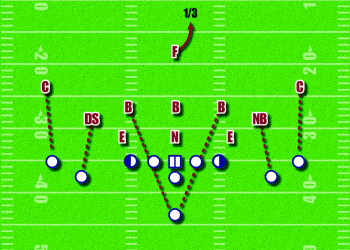
Diagram 3. The defensive ends, if not included in the blitz, will always perform what Burks calls a “jacks” stunt. That is getting a hard up field rush outside the tackle, taking on contain responsibilities in the pass. Even high school programs are getting in on the act. David Prince, the defensive coordinator at Lake City High School in South Carolina, switched to the front two years ago and has seen his opponent’s offensive production cut in half. “We move our front 90 percent of the time. It’s something we can’t do enough of. We do so much stunting, they have to have quick feet and be able to redirect. If a kid can’t run, he’ll have to go play offense for us,” says Prince. But stunting is a technique that must be coached. The key is coming full speed, but under control. One of the drills that Prince does with his d-line is a three step stunt move where on the first step they move their right or left foot depending on the direction of the stunt. The second step is up field to get penetration, and the third step is redirection down the line of scrimmage. Ron Burton, the defensive line coach at the Air Force Academy teaches what he calls the “angle technique” when his players are working on stunting. On any stunt, either inside or outside, he coaches an aiming point- the inside hip of the next adjacent lineman, usually the guards for the two defensive ends. There are two reads that will show. First is when that hip comes away from you, which usually means that there is a backside pull coming at you. Burton teaches his players to work down the line of scrimmage, expecting trap or counter. The second read is the hip coming directly at you, which usually means the play is coming to your side. Here, the defensive lineman is taught to attack and knock the guard back, maintaining his initial gap responsibility. He’s repped the drill so well, Burton feels that by constantly moving, you’re cutting down the opponents playbook while expanding your teaching time. “You’re dictating to the offense what they can run against you. Teams cannot tee off on you, so they’ll run zone schemes. Now you have all the time in the world just to rep blocking schemes on the zone play,” says Burton. He’ll even have his defensive line align about 18 inches off the line of scrimmage, something uncanny for traditional d-line play, not to press the line of scrimmage. He calls it an “ability adjustment” depending on how good the offensive lineman is they’re keying. It’s to prepare to defend any type of blocks the line shows, and to get better angles on movement. While Williams and Burton’s “you know it’s coming, now try and stop it” approach has worked wonders at their schools, other programs are finding success in the odd stack by lining up and playing read and react football- without the use of various stunts and blitzes. Defensive coordinator Keith Patterson at the University of Tulsa only stunts on about 10 percent of snaps during a game the course of the year. His philosophy served him well. The Golden Hurricane is coming off a 9-4 season, winning the Conference USA Championship the first year they’re in the league. Patterson teaches what he calls “anchor points” to his defensive line. The term anchor, tells his line to stay put, and read your keys without trying to fly up the field and make plays. “We don’t move too much. We will just stay put, especially in short yardage situations. We want to teach them how to line up and play gap-controlled, fundamental football. We’ll change our alignment but we don’t like to slant and move a lot. It becomes difficult to fit our run game responsibilities around them,” says Patterson. Tulsa also plays the odd stack with a zero technique and two five techniques on the line of scrimmage, but they are readers of blocks. The nose has an anchor point of the center’s facemask. His job is to attack and neutralize the center on every snap. The ends anchor point is the outside “V” of the neck of the offensive tackles, and they must learn how to react to three blocks – the down, the base and the reach. When Patterson wants to bring pressure, he does so by alignment, not by stunting the front. In his stack shade (Diagram 4) 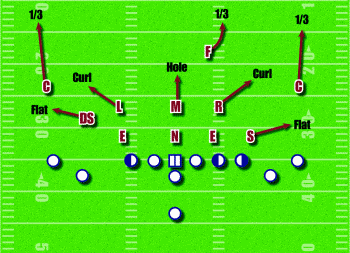
Diagram 4. he’ll bring an outside linebacker outside the tight end side to play contain, which tells the end to move inside to a four eye technique (inside eye of the tackle). Patterson preaches gap integrity that matters most – the d-line and linebackers are all responsible for a gap, and playing out of that gap takes you out of position to make plays and opens up seams in the defense. So, whether you’re planning on using it to attack, as an up field scheme or as your base defense, the odd stack has been a proven commodity at the collegiate and high school levels. It will help you to match skills with the best athletes the offense can put on the field on any given snap. Two different styles of defensive line play in the odd stack Teaching the Angle Technique – Air Force Academy • Don’t press the line of scrimmage- stay between 12-18 inches off the football. • Stunt into designated gap, stay flat down line of scrimmage, and don’t work up field. • Read the near hip of the next adjacent offensive lineman. If it comes to you, knock it back, maintain gap integrity. If it goes away, work down L.O.S. looking for a backside pull. Teaching the Anchor Technique – University of Tulsa • Crowd the line of scrimmage. • Burn your eyes on your sight key: Nose - helmet screws of the center Ends - outside “V” of the offensive tackle • Be able to react to a down block or drive block, but do not get reached if you are an end. • Work to keep offensive lineman from working to the second level (linebackers). |
|
| HOME |
MAGAZINE |
SUBSCRIBE | ONLINE COLUMNISTS | COACHING VIDEOS |
Copyright 2025, AmericanFootballMonthly.com
All Rights Reserved




